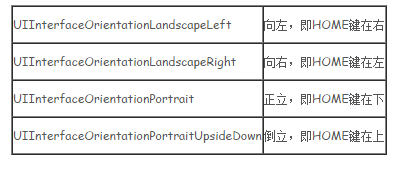IOS 粒子體系 (CAEmitterLayer)實例詳解
1、體系分析
在UIKit中,粒子體系由兩部門構成:
· 一個或多個CAEmitterCells:發射器電池可以看做是單個粒子的原型(例如,一個單一的粉撲在一團煙霧)。當披發出一個粒子,UIKit依據這個發射粒子和界說的基本上創立一個隨機粒子。此原型包含一些屬性來掌握粒子的圖片,色彩,偏向,活動,縮放比例和性命周期。
· 一個或多個CAEmitterLayers,但平日只要一個:這個發射的層重要掌握粒子的外形(例如,一個點,矩形或圓形)和發射的地位(例如,在矩形內,或邊沿)。這個層具有全局的乘法器,可以施加到體系內的CAEmitterCells。這些給你一個簡略的辦法籠罩的一切粒子的變更。好比一小我為的例子將轉變x雨來模仿風的速度。
基本是簡略的,但這些參數倒是相當奧妙的。CAEmitterLayer有跨越30種分歧的參數停止自界說粒子的行動。上面,我就拼出來的一些特別成績
2、弗成測性
1、是甚麼讓粒子體系成為一個隨機的體系?
CAEmitterCell的屬性普通有兩個參數:一個均值和一個“cone”,好比velocity 和velocityRange。
默許情形下,這個“cone”是0,這就認為著一切粒子將具有雷同的速度。經由過程轉變這個“cone”,每一個發射粒子會隨機被擾動取得一個這個“cone”規模內的值。這點在Apple官方文檔CAEmitterLayer documentation: 有講授:
Each layer has its ownrandom number generator state. Emitter cell properties that are defined as amean and a range, such as a cell's speed, the value of the properties areuniformly distributed in the interval [M - R/2, M + R/2].
2、發射的偏向
CAEmitterCells有一個velocity(速度)的屬性,這意味著發送偏向上的速度。現實上這個發射的偏向是經由過程emissionLongitude屬性界說的。Apple如許論述的:
The emission longitude is theorientation of the emission angle in the xy-plane. it is also often referred toas the azimuth.
3、代碼
- (void)viewDidLoad
{
[super viewDidLoad];
CAEmitterLayer *emitterLayer = [CAEmitterLayer layer];
emitterLayer.emitterPosition = self.view.center;
_emitterLayer = emitterLayer;
[self.view.layer addSublayer:emitterLayer];
CAEmitterCell *funnyEmitterCell = [CAEmitterCell emitterCell];
funnyEmitterCell.contents = (id)[UIImage imageNamed:@"funny.jpg"].CGImage;
funnyEmitterCell.birthRate = 10.0;
funnyEmitterCell.velocity = 200.0;
funnyEmitterCell.lifetime = 5.0;
funnyEmitterCell.scale = 0.1;
funnyEmitterCell.name = @"funny";
emitterLayer.emitterCells = [NSArray arrayWithObject:funnyEmitterCell];
[self bumpAngle];
UILabel *angleLabel = [[UILabel alloc] initWithFrame:CGRectMake(20, 20, 100, 30)];
angleLabel.backgroundColor = [UIColor clearColor];
[self.view addSubview:angleLabel];
_angleLabel = angleLabel;
}
- (void) bumpAngle {
NSNumber *emissionLongitude = [_emitterLayer valueForKeyPath:@"emitterCells.funny.emissionLongitude"];
NSNumber *nextLongitude = [NSNumber numberWithFloat:[emissionLongitude floatValue] + 0.02];
[_emitterLayer setValue:nextLongitude forKeyPath:@"emitterCells.funny.emissionLongitude"];
_angleLabel.text = [NSString stringWithFormat:@"%.0f degrees", [nextLongitude floatValue] * 180 / M_PI];
[self performSelector:@selector(bumpAngle) withObject:nil afterDelay:0.1];
}
代碼設置/構造解釋:
1、CAEmitterCell
CAEmitterCell *effectCell = [CAEmitterCell emitterCell];
effectCell 幾個主要屬性:
1).birthRate 望文生義沒有這個也就沒有effectCell,這個必需要設置,詳細寄義是每秒某個點發生的effectCell數目
2).lifetime & lifetimeRange 表現effectCell的性命周期,既在屏幕上的顯示時光要多長。
3).contents 這個和CALayer一樣,只是用來設置圖片
4).name 這個是當effectCell存在caeEmitter 的emitterCells頂用來識別的。用到setValue forKeyPath比擬有效
5).velocity & velocityRange & emissionRange 表現cell向屏幕左邊飛翔的速度 & 在左邊甚麼規模內飛翔& +-角度分散
6).把cell做成array放進caeEmitter.emitterCells裡去。caeEmitter.renderMode有個後果很不錯,能釀成火的就是kCAEmitterLayerAdditive
屬性:
alphaRange: 一個粒子的色彩alpha能轉變的規模;
alphaspeed:粒子通明度在性命周期內的轉變速度;
birthrate:粒子參數的速度乘數因子;
blueRange:一個粒子的色彩blue 能轉變的規模;
blueSpeed: 粒子blue在性命周期內的轉變速度;
color:粒子的色彩
contents:是個CGImageRef的對象,既粒子要展示的圖片;
contentsRect:應當畫在contents裡的子rectangle:
emissionLatitude:發射的z軸偏向的角度
emissionLongitude:x-y立體的發射偏向
emissionRange;四周發射角度
emitterCells:粒子發射的粒子
enabled:粒子能否被襯著
greenrange: 一個粒子的色彩green 能轉變的規模;
greenSpeed: 粒子green在性命周期內的轉變速度;
lifetime:性命周期
lifetimeRange:性命周期規模
magnificationFilter:不是很清晰似乎增長本身的年夜小
minificatonFilter:減小本身的年夜小
minificationFilterBias:減小年夜小的因子
name:粒子的名字
redRange:一個粒子的色彩red 能轉變的規模;
redSpeed; 粒子red在性命周期內的轉變速度;
scale:縮放比例:
scaleRange:縮放比例規模;
scaleSpeed:縮放比例速度:
spin:子扭轉角度
spinrange:子扭轉角度規模
style:不是很清晰:
velocity:速度
velocityRange:速度規模
xAcceleration:粒子x偏向的加快度重量
yAcceleration:粒子y偏向的加快度重量
zAcceleration:粒子z偏向的加快度重量
2、CAEmitterLayer
CAEmitterLayer供給了一個基於Core Animation的粒子發射體系,粒子用CAEmitterCell來初始化。粒子畫在配景層盒界限上
屬性:
birthRate:粒子發生系數,默許1.0;
emitterCells: 裝著CAEmitterCell對象的數組,被用於把粒子投放到layer上;
emitterDepth:決議粒子外形的深度接洽:emittershape
emitterMode:發射形式
NSString * const kCAEmitterLayerPoints;
NSString * const kCAEmitterLayerOutline;
NSString * const kCAEmitterLayerSurface;
NSString * const kCAEmitterLayerVolume;
emitterPosition:發射地位
emitterShape:發射源的外形:
NSString * const kCAEmitterLayerPoint;
NSString * const kCAEmitterLayerLine;
NSString * const kCAEmitterLayerRectangle;
NSString * const kCAEmitterLayerCuboid;
NSString * const kCAEmitterLayerCircle;
NSString * const kCAEmitterLayerSphere;
emitterSize:發射源的尺寸年夜;
emitterZposition:發射源的z坐標地位;
lifetime:粒子性命周期
preservesDepth:不是多很清晰(粒子是平坦在層上)
renderMode:襯著形式:
NSString * const kCAEmitterLayerUnordered;
NSString * const kCAEmitterLayerOldestFirst;
NSString * const kCAEmitterLayerOldestLast;
NSString * const kCAEmitterLayerBackToFront;
NSString * const kCAEmitterLayerAdditive;
scale:粒子的縮放比例:
seed:用於初始化隨機數發生的種子
spin:自扭轉速度
velocity:粒子速度
4、Demo下載
以上就是對IOS 粒子體系的材料整頓,後續持續彌補相干材料,感謝年夜家對本站的支撐!
【IOS 粒子體系 (CAEmitterLayer)實例詳解】的相關資料介紹到這裡,希望對您有所幫助! 提示:不會對讀者因本文所帶來的任何損失負責。如果您支持就請把本站添加至收藏夾哦!
- 上一頁:詳解iOS當地推送與長途推送
- 下一頁:IOS 運用之間的跳轉和數據傳遞詳解




